What are Heterotrophs? types and examples
`
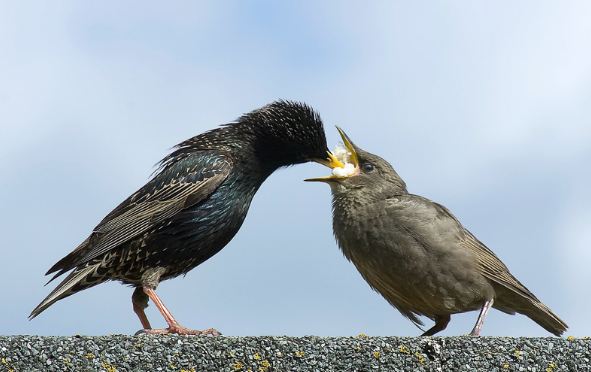
Heterotroph
Every moment you’re alive, your body is using energy, even if you’re just sitting here reading this lesson. Where does that energy come from? Our energy is acquired through eating food, like pizza for lunch. Organisms that depend on other organisms for food, and thus energy, like us, are called heterotrophs.
Heterotroph Definition
A heterotroph is an organism that cannot manufacture its own food by carbon fixation and therefore derives its intake of nutrition from other sources of organic carbon, mainly plant or animal matter. In the food chain, heterotrophs are secondary and tertiary consumers.
Main Types of Heterotrophs
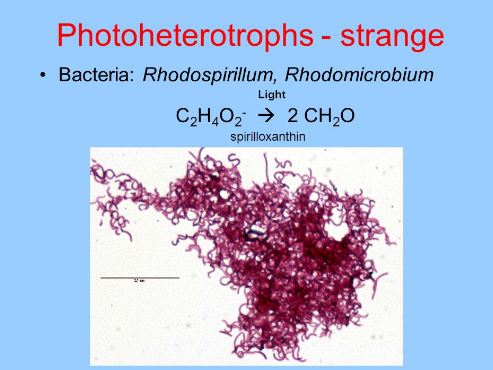
There are two forms of heterotroph, Photoheterotrophs, and chemoheterotrophs.
- Photoheterotrophs (Gk: photo = light, hetero = (an)other, troph = nourishment) use light for getting energy, but they are unable to use carbon dioxide of the air as their carbon source and, therefore, obtain carbon-based organic compounds from their environment. Heliobacteria and certain proteobacteria are photoheterotrophs.
- Chemoheterotrophs (Gk: chemo = chemicals, hetero = (an)other, troph = nourishment) obtain their energy from ingesting preformed organic energy sources such as lipids, carbohydrates, and proteins which have been synthesized by other organisms.
By consuming reduced carbon compounds, heterotrophs are able to use all the energy that they consume for growth, reproduction and other biological functions.
Some heterotrophs, called herbivores, only eat plants. The herbivores only get 10% of the energy available from the autotrophs, because the producers used 90% of their energy to grow and reproduce. So, there are substantially fewer herbivores in an ecosystem compared to autotrophs since they get less energy. Consider our field. There are millions of blades of grass, but only one herd of about twenty deer.
Types and examples of Heterotroph
1- Herbivores or primary consumers
“Type of heterotrophs that eat plants to obtain their nutrition are called herbivores, or primary consumers”
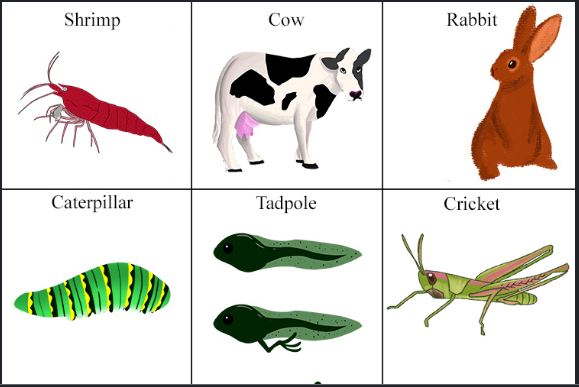
Herbivores feed directly on the biomass of plants which mostly consist of cellulose, starch, lipids, proteins, etc. Plants are autotrophs and are able to convert inorganic molecules of the environment (carbon dioxide and water) into energy-rich organic molecules and build their biomass which becomes the food of the herbivores later on.
Starch content of autotrophs is easily broken down by most animals, due to the presence of an enzyme secreted from the salivary glands and pancreas called amylase.
Cellulose, which is a major component of plant cell walls and an abundant carbohydrate, converted from inorganic carbon, is harder to digest for many animals. Most herbivores have symbiotic organisms in their gut which breaks down the cellulose into a usable form of energy.
Examples of herbivores include cows, sheep, deer, and other ruminant animals, which ferment plant material in special chambers (stomach) containing the symbiotic organisms. Animals that eat only fruit, such as birds, bats, and monkeys, are also herbivores, although they are called frugivores.
Mostly plant material consists of hard-to-digest cellulose, but plant nectar consists of mostly simple sugars and is eaten by herbivores called nectarivores, such as hummingbirds, bees, butterflies, and moths.

2- Carnivores
A carnivore, meaning “meat eater”, is an organism that derives its energy and nutrient requirements from a diet consisting mainly or exclusively of animal tissue, whether through predation or scavenging. They feed on herbivores, omnivores, and other carnivores in an ecosystem. A natural community depends on the presence of carnivores to control the population of other animals in the ecosystem.
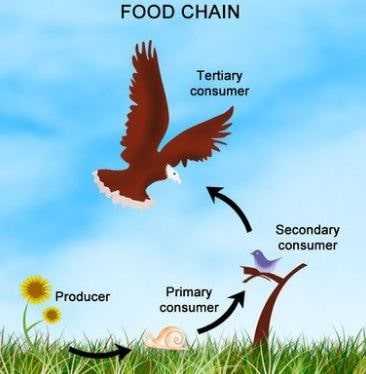
Types of carnivores
- Secondary consumers: Carnivores are usually predators means that they prey on other animals for eating. The type of carnivores that directly feed herbivores (plant eaters) are called secondary consumers.: Examples of secondary consumers include snakes, birds, and frogs (mostly Insect eaters) and marine organisms that consume zooplankton such as small fish, crabs, and jellyfish.
- Tertiary consumers: There is another type of carnivores that even eat secondary consumers. These are second level carnivores. These are tertiary consumers, the animal that feeds secondary consumers.

“Let’s take an example to understand clearly”.
Plants are autotrophs or producers. The Grasshopper which eats the plants is a first-level consumer or primary consumer. But the Bluebird which eats Grasshopper is called the second-level consumer or secondary consumer. There is another organism in the food chain that can eat Bluebird as well, the Snake, It is called a third-level consumer or Tertiary consumer. Both secondary and tertiary consumers are called carnivores because they prey on other animals.
- scavengers: Carnivores may also be scavengers, animals such as vultures or cockroaches, which eat animals that are already dead. They are also meat-eaters, but rather than capturing prey they prefer to feed on animals remains left behind by predators. When predators go away after a meal, the scavengers arrive at the remains to finish off anything that hasn’t been eaten. Examples are Carrion beetle, Blowflies, vultures and cockroaches, etc.
Energy transfer from autotrophs to carnivores
Autotrophs are called so because they are able to convert energy-poor inorganic compounds into energy-rich organic compounds. Heterotrophs feed on the autotrophs and in this way autotropic body energy is transferred in the bodies of heterotrophs.
The carnivores can also get energy which mainly comes from lipids (fats) and muscular biomass that the herbivore has stored within their bodies. Small amounts of glycogen (a polysaccharide of glucose which serves as a form of long term energy storage) are stored within the liver and in the muscles and can be used for energy intake by carnivores, although the supply is not abundant.
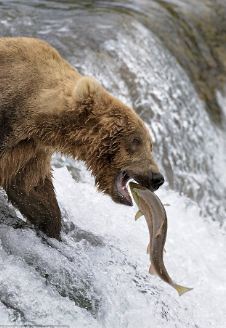
3- Omnivores
These are unique in their nutrition as they can eat plants as well as the meat from other animals. It depends upon the availability of the type of food. Their bodies are adopted for both types of food products i.e. plant products or animal flesh. They can capture other animals for their food and if not available they can eat plant products such as leaves, fruits, stems, roots, etc.
The best example of omnivores is human beings. we are adopted not only for capturing prey but also for digestion of plant products in our bodies.
Omnivores get only 10% of the energy of the herbivores, so they end up with only 1% of the energy that was present in the autotrophs. Thus, they are going to be even fewer as compared to herbivores.
Examples
- Common mammalian omnivores include raccoons, opossums, skunks, pigs, rats, badgers, and most bear species.
- Omnivorous birds, including chickens, crows, and robins.
- Some reptiles, such as lizards and turtles, are also omnivorous.
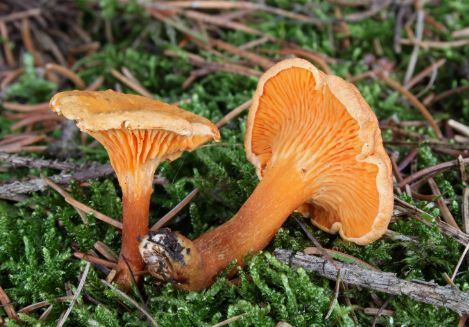
4- Fungi, an absorptive heterotroph
Fungi are heterotrophic organisms, although they do not ingest their food as other animals do, but feed by absorption. Fungi have root-like structures called hyphae, that grow and form a network through the substrate on which the fungi is feeding. These hyphae secrete digestive enzymes, which break down the substrate, making digestion of the nutrients possible.
Fungi feed on a variety of different substrates, such as wood, cheese or flesh, although most of them specialize on a restricted range of food sources; some fungi are highly specialized and are only able to obtain nutrition from a single species.
Types of fungi
- Many fungi are parasitic, which means they feed on a host without killing it.
- Most fungi are saprobic, meaning they feed on already dead or decaying material, such as leaf litter, animal carcasses, and other debris. The saprobic fungi recycle the nutrients from the dead or decaying material, which becomes available as nutrients for animals that eat fungi. The role of decomposers that fungi have as recyclers at all trophic levels of the nutrient cycle is extremely important within ecosystems, although they are also highly valuable to humans economically.
- Many fungi are responsible for the production of human food, such as yeast (Saccharomyces cerevisiae), which is used to make bread, beer, and cheese. Fungi are also used as medicines, such as penicillin.
“There is no point in discussing the different levels of consumers or carnivores if we are not well aware of autotrophs or producers”
So, What are Autotrophs?… The starting point of this food web…
Although eating might seem like the only way to get food, think for a minute about how plants get their food. They don’t eat, but rather they create their own food from sunlight or chemicals that are then used to generate the energy they need to grow and reproduce. Organisms that make their own food are called autotrophs.
Typically, we think of plants as autotrophs, and this is true, but there are other kinds as well. Plants, algae, phytoplankton, and some bacteria are photosynthetic, meaning they use sunlight to make sugar, which they then use to make energy.
Photosynthetic organisms are green because they contain a pigment called chlorophyll that does photosynthesis. Some other types of bacteria are also autotrophic, but they are chemosynthetic. They use the energy stored in chemicals, usually released from deep-sea vents, to make their food, and then energy.
Carbon fixation is the process of converting inorganic carbon (CO2) into organic compounds such as carbohydrates, usually by photosynthesis. Organisms, which can use carbon fixation to manufacture their own nutrition, are called autotrophs.
- Autotrophs form the basis of all food webs. They gather energy from inorganic sources, like chemicals or the sun, and convert it into a form that other animals can use.
- Energy is transferred from the autotrophs to consumers that eat them and then to carnivores that eat those animals. Without autotrophs, all of our food webs would collapse.
- Since there is so much energy available to this layer of the food web, autotrophs have the greatest number of organisms in an ecosystem. Think of how many blades of grass there are in a field compared to how many bears you typically see.
- Autotrophs also have an easier time finding a suitable environment. All they need are the right conditions and plenty of sunlight or chemicals to survive and flourish.
Related Biology Terms
- Autotroph – Also known as ‘primary producers’, these are organisms that can fix inorganic carbon as an energy source; most plants are autotrophs.
- Energy pyramid – The flow of energy through a food chain can be visualized as a pyramid, as energy is lost throughout each level.
- Trophic Level – One of the hierarchal levels of a food chain in an ecosystem.
- Nutrient Cycle – The movement or exchange of inorganic and organic material in the production of living organisms.
